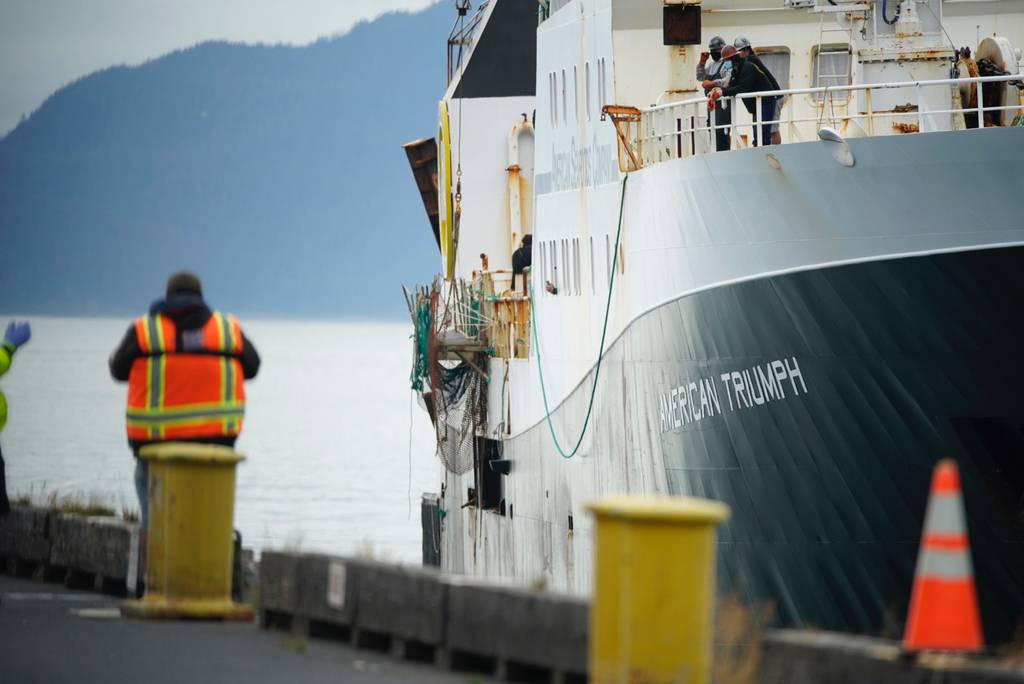Anchorage Daily News Opinions – By Bob Hezel and TJ Durnan – December 10, 2021 •

The factory trawler American Triumph docks in Seward on July 22, 2020. (Loren Holmes / ADN)
We are two captains with a combined experience of more than 70 years in Alaska’s groundfish trawl fisheries.
In that time, we’ve been a part of a trawl fishery that has evolved and innovated heavily to meet several regulatory challenges. This is thanks to a collective commitment of the 2,200 fishermen and women who participate in our fishery. Our families are fishing families, too – as important as any other. We believe we are true stewards of the North Pacific resources. But cuts to our halibut bycatch caps under consideration by the North Pacific Fishery Management Council at its upcoming December meeting threaten our fishery and our way of life.
Our fleet has achieved a 49% reduction in halibut bycatch mortality since Amendment 80 rationalization in 2007. Halibut now represents 0.4% of our catch, which is among Alaska’s lowest bycatch rates, and far lower than Canada’s West Coast fisheries, which are often held up as an example of low bycatch rates. But it has not been easy to get here.
Over the past 10 years, we have designed and developed numerous technologies to lower bycatch in our nets, including halibut excluders and elevated sweeps to reduce bottom contact. These technologies have been implemented with great cost in time, material, and lost productivity of our vessels — not to mention all the frozen hours out on deck for our crews who have willingly helped us to create and refine these devices. While some of these gear modifications showed promise for reducing halibut catches initially, now that halibut are mostly about the same size as our target fish there is no sensible reason to expect that anything more than very marginal gains will come from additional innovation in the field of net and excluder design. This is the industry consensus of captains, net and excluder engineers, and technicians.
We have also worked hard to develop operational methods of reducing halibut bycatch. As a fleet, we’ve developed deck sorting procedures which greatly reduce halibut mortality, returning far more of these fish live to the sea while maintaining accurate observer accounting. We started this work in 2009 with two vessels, expanding and refining the program over many years. This program has been a remarkable success, and it has recently been accepted into regulation by the National Marine Fisheries Service. However, the consensus of captains, scientists and crews is that all the gains from these methods have already been achieved.
While we are always looking for new innovations, we know of no new piece of gear that gets us to a place where we can take another cut. This means that the halibut cuts under consideration for our fleet will force a dramatic contraction in the target harvest. This will have devastating impacts on our fishery and the people who work so hard in it. The council’s own review acknowledges that there are no new tools for us and indicates that an average Amendment 80 crew member stands to lose $24,000 to $48,000 in income annually from the cuts the council is considering. The benefit to a halibut crew member for cuts to our fishery? $500 to $1,000 a person.
The people in western Alaska who provide goods and services also stand to lose a large source of revenue due to the harvest contraction. Unlike many other fisheries, our sector has traditionally operated year-round, and we bring much needed economic opportunity to coastal communities. This year-long stability and revenue is in danger.
Too often, this issue has been framed as a battle between small operators vs. large corporations. We are not large corporations. We are people and this is our job. We are 2,200 crew members who work tirelessly to earn an honest, decent living and support our families. Our crews come from all walks of life, and we have been able to provide a standard of living that many may not have been able to achieve elsewhere.
The council’s proposed cuts might be understandable if there were a proportional gain to another fishery or a conservation benefit, but the council’s own analysis states that cutting our halibut bycatch further will not improve halibut stocks or yield conservation benefits. According to the science, our halibut bycatch is not the cause of declines in the halibut fishery.
So, when the council meets on halibut bycatch in early December, they need to look to their own science and not make cuts that threaten our fishery and provide no benefit to halibut fishermen. Our families are depending on it.
Bob Hezel is captain of C/P America’s Finest and TJ Durnan is captain of C/P Alaska Spirit, two factory trawlers for Fishermen’s Finest and O’Hara Corp., based in the Seattle area. Both boats fish for wild Alaska sole and flounder, Pacific cod, Pacific ocean perch, and Atka mackerel in Alaska’s Bering Sea.
The views expressed here are the writer’s and are not necessarily endorsed by the Anchorage Daily News, which welcomes a broad range of viewpoints. To submit a piece for consideration, email commentary(at)adn.com. Send submissions shorter than 200 words to letters@adn.com or click here to submit via any web browser. Read our full guidelines for letters and commentaries here.